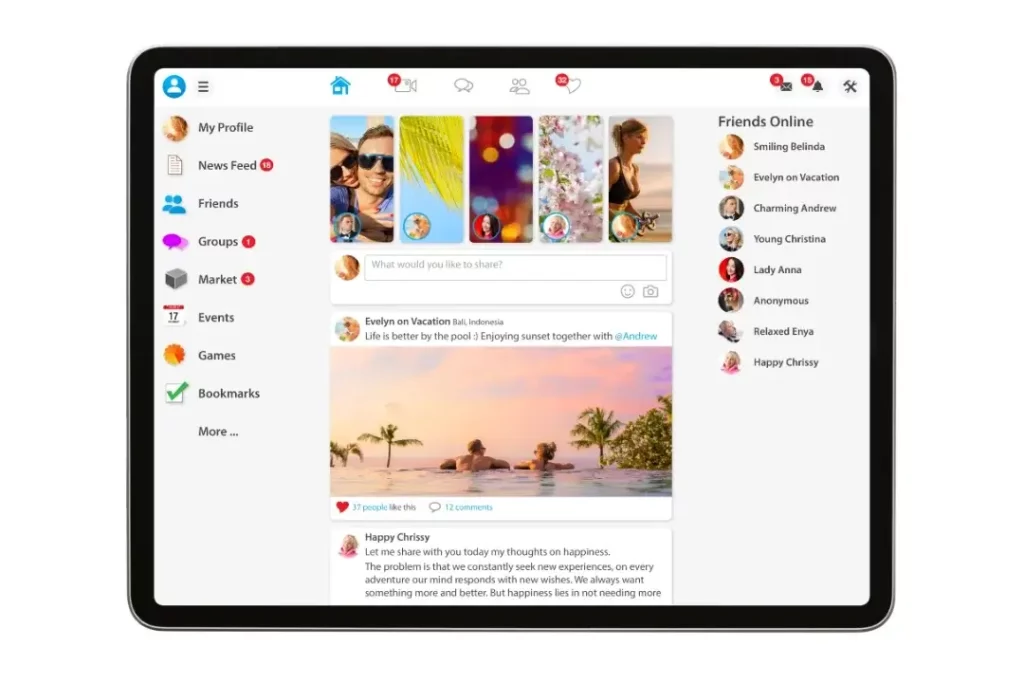
Dream, Create, Inspire: 15 Types Of Websites You Can Create In 2023!
Stay Ahead of the Curve: Trendsetting Website Concepts for 2023!
The Internet is like a big playground filled with all sorts of fun stuff. If you want to build something on this playground, like a tree house. You need to decide what kind of tree house you want. Is it a clubhouse, a library, or a play area? Well, websites are a bit like that too! If you want to create your own space on the internet, just like a tree house in the digital world. But before you begin, you need to pick the right kind of tree house – or in this case, the right kind of website. There are all sorts of websites out there, each with its own special features and uses.
So, why is it important to know about these different types of websites? Because it’s like picking the right tools for the job. If you’re telling stories, you might want a blog. If you’re selling things, an online store is your go-to. And if you have a big idea for an app, well, there are types of websites for that too. So If you’re curious about how many types of websites there are, we’ve got you covered. Look our more Blogs. Click here.
1. Ecommerce Website

An Ecommerce website is a fundamental digital tool and a crucial aspect of the modern business landscape. These sites act as virtual storefronts, allowing businesses to showcase and sell products digitally and operate round the clock. By doing so, businesses can reach out to a broader, global audience, breaking the geographical limitations that are inherent to traditional brick-and-mortar stores.
Having an eCommerce store not only significantly boosts the potential for sales but also offers customers a high level of convenience and flexibility. With the steady surge of online shopping, having an eCommerce website has become inevitable for businesses looking to stay competitive.
How to Build an Ecommerce Website
The process of building an eCommerce website involves several crucial steps:
Identifying Your Product and Target Audience
This is the foundational step for any eCommerce venture. Thorough market research will help in understanding what your potential customers want and how your products or services can fulfill their needs.
Choosing an Ecommerce Platform
The right platform can make or break your online store. It’s essential to pick one that fits your business requirements and budget. Other factors to consider include scalability, security features, and the platform’s ability to integrate with other systems.
Designing Your Site
Customers appreciate a site that’s visually appealing and easy to navigate. Keep your design simple, uncluttered and make sure that your products are the stars of your site.
Setting Up Payment and Shipping Options
It’s important to offer various payment options and clearly outline your shipping policies. Keep the check-out process straightforward and secure.
Launching and Marketing Your Site
Once your site is ready, it’s time to launch and promote it. Use SEO to improve your site’s visibility on search engines, engage on social media platforms, and consider pay-per-click advertising to attract more traffic to your site.
Real Life Examples of Ecommerce Websites
- Zalando: A leading European eCommerce company, Zalando offers an extensive range of clothing and accessories for men, women, and children, enabling shoppers to browse through thousands of styles and brands.
- Instacart: Instacart offers grocery delivery and pick-up services from a variety of local stores. It demonstrates how eCommerce can successfully be applied outside of traditional retail sectors.
- Wayfair: Specialized in home goods, Wayfair connects shoppers with over 18 million items for their home, showcasing the vast potential product selection an Ecommerce site can offer.
- ASOS: ASOS is an excellent example of a niche eCommerce fashion platform, serving primarily young adults with trendy fashion and beauty products.
- Chewy: Catering to pet owners, Chewy is an online retailer that sells pet food, supplies, and prescription medication, thus demonstrating the potential of niche eCommerce.
2. Social Media Website

A social media website is a platform where users can create profiles, share their interests, photos, videos and interact with one another. These websites can be used for numerous purposes, ranging from connecting with friends and family, making business connections, and sharing content. They play a key role in today’s digital era, influencing the way people communicate, work, study, and even shop.
How to Build a Social Media Website
Building a social media website is a multi-step process:
- Planning: Define your goals, audience, and determine what features your website will have. This could include user profiles, a news feed, chat capabilities, etc.
- Design: Sketch the design of the main pages and features on paper or using a wire frame tool. Make sure the design is user-friendly and appealing.
- Choose a Platform: Depending on your specific needs and budget, you can either choose to build your social media site from scratch, use a content management system like WordPress, or a specialized social network builder.
- Development: This is where the coding happens. Depending on your skills and budget, you can do it yourself or hire a professional developer or agency. It’s also important to set up a database to store user data securely.
- Testing: Before launching, make sure to test your site rigorously to ensure there are no bugs and that all features work as intended.
- Launch and Marketing: Once your site is ready , launch it to the public and begin promoting it through various marketing channels. This may include search engine optimization for better visibility, social media marketing to engage with potential users, content marketing to provide valuable content, and paid advertising for immediate exposure.
Real Life Examples of Social Media Websites
- Facebook: The world’s largest social network, Facebook allows users to create profiles, share photos and videos, send messages, and keep in touch with friends, family, and colleagues.
- LinkedIn: A professional networking site, LinkedIn serves as a platform for employers to post jobs and job seekers to post their CVs. It’s also used for professional networking, typically among industries and businesses.
- Instagram: Primarily used for photo and video sharing, Instagram is a highly visual platform that allows users to create and decorate their posts with filters and interactive stickers.
- Twitter: Twitter is a micro blogging site that allows users to post and interact with messages known as ‘tweets’. It’s often used for news dissemination, allowing for rapid spread of information.
- Pinterest: Pinterest is a pinboard-style photo-sharing website where users can create and manage theme-based image collections such as events, interests, hobbies and more.
- TikTok: TikTok is a social media platform for creating, sharing and discovering short music videos. It’s particularly popular among millennials and Gen Z.
3. Blog Website

A blog website is an online platform where individuals, groups, or entities can regularly post content on various topics. It serves as a channel to share thoughts, ideas, experiences, and knowledge while engaging and interacting with readers. This type of website enhances communication and promotes a better understanding of the world from different perspectives.
How to Create a Blog Website:
Creating a blog website involves various steps:
- Choose a Blogging Platform: Select a blogging platform that suits your needs. WordPress, Blogger, and Tumblr are popular choices.
- Select a Domain Name: The domain name is your blog website’s address on the internet. Choose a unique and memorable domain.
- Get a Web Hosting Account: A web hosting account is where your blog website will live on the internet. Choose a reliable host with good customer service. Design Your Blog:Customize your blog with a theme that aligns with your content and audience. Ensure it is functional and visually appealing.
- Start Writing and Publishing Posts: Begin creating content for your blog. Ensure your posts are engaging, well-written, and relevant to your audience.
- Promote Your Blog: Use social media, SEO strategies, and other marketing methods to drive traffic to your blog.
Real Life Examples of Blog Websites
- TechCrunch: TechCrunch is a popular technology blog that reports on the latest trends and developments in the tech and startup industry.
- HuffPost: Initially a news and opinion blog, HuffPost has grown into a well-known media platform that covers a wide range of topics from politics to lifestyle.
- Moz: Moz is a SEO-focused blog that educates readers about the latest in search engine optimization strategies and digital marketing.
- The Verge: The Verge is a technology blog that provides readers with just about everything related to the technology world, including news, reviews, and in-depth features.
- The Pioneer Woman: Run by Ree Drummond, this blog focuses on food and lifestyle, showcasing easy-to-follow recipes, decorating tips, and personal anecdotes.
4. Business Website

A business website serves as the digital hub for your business, offering information about your company, its products or services, and how customers can get in touch with you. More than just an online presence, a business website has the potential to boost your business’s visibility, credibility, and ultimately its bottom line.
How to Create a Business Website?
Creating a business website involves a few essential steps:
- Choosing a Domain Name: This is your website’s address on the web. It should be related to your business name for easy recognition.
- Selecting a Web Host: This is the place where your website’s files are stored. Choose a host that provides excellent uptime, customer service, and suitable storage options.
- Picking a Website Builder or Platform: Website builders like Wix or WordPress make it simple to design professional-looking websites with no coding knowledge.
- Designing the Website: Carefully plan your website’s layout, colors, and overall aesthetics to match your brand and appeal to your target customers.
- Creating Essential Pages: These typically include the home page, about us, product/service pages, contact us, and sometimes a blog or news section.
- Setting up SEO: Incorporate relevant keywords and follow best SEO practices to help your website rank higher in search engine results.
- Adding Contact Forms or Online Chat: These tools allow potential clients to easily reach out to you.
Real Life Examples of Business Websites
- Apple: Apple’s website is a perfect example of how a business website can showcase products and services.
- Starbucks: Starbucks uses its website to connect with customers, update them with the latest offers, and provide detailed information about their menu.
- Nike: Nike’s website is not just a place to shop; it’s also an excellent platform for brand promotion and customer interaction.
- IBM: IBM uses its website as a knowledge hub, sharing insights, research, and latest technologies related to their industry.
- Zillow: Real estate company Zillow capitalizes on its website by providing a comprehensive platform for home buyers and sellers to search for properties, calculate mortgage payments, and access valuable real estate information.
- Salesforce: Salesforce’s website serves as a hub for businesses looking for customer relationship management (CRM) solutions, providing information on their products, success stories, and resources for businesses to improve their sales and customer service processes.
5. Dynamic Web page Websites

A dynamic webpage website is a type of website that generates content on the fly, based on user interactions or data inputs. Unlike static websites, which deliver the same content to every user, dynamic websites can display personalized or updated information tailored to each user’s needs or preferences.
How to Create a Dynamic Web page Website
To create a dynamic webpage website, you typically need to:
- Choose a server-side programming language like PHP, Python, or Ruby.
- Set up a server to host your website.
- Design a database to store and retrieve dynamic content.
- Write code to handle user requests, process data, and generate dynamic HTML output.
- Implement a front end design to display the dynamic content to users.
Real Life Examples of Dynamic Web page Websites
- Netflix: Netflix is a prime example of a dynamic webpage website. It personalizes the content it displays to each user based on their viewing history and preferences, providing personalized recommendations and a unique user experience.
- Facebook: Facebook uses dynamic web pages to generate users’ personalized news feeds, notifications, and messages. The content is constantly updated based on user activities and interactions.
- Amazon: Amazon dynamically generates product recommendations, personalized search results, and pricing information based on user behavior and purchase history.
- Expedia: Expedia’s website dynamically generates search results for flights, hotels, and rental cars based on user inputs such as travel dates, destinations, and preferences. The website also displays real-time availability and pricing information.
- YouTube: YouTube dynamically generates personalized video recommendations, playlists, and suggested content based on a user’s viewing history, interactions, and preferences.
6. Personal Webpage Website

A personal webpage website allows individuals to create and showcase their own websites, representing their personal brand or interests. These websites provide a platform to share information about oneself, showcase portfolio work, promote personal projects, or simply express personal thoughts and ideas online.
How to Create a Personal Web page Website
To create a personal webpage website, you can follow these general steps:
- Choose a website builder: Pick a website builder platform that suits your needs and doesn’t require extensive technical knowledge. Some popular options include WordPress, Wix, Squarespace, and Weebly.
- Select a template or design theme: Once you’ve chosen a website builder platform, select a template or design theme that aligns with your personal style and goals for the website.
- Customize your website: Personalize your website by adding your own content, such as a bio, photos, blog posts, or any other information you’d like to share. Customize the layout, color scheme, fonts, and other visual elements to create a unique and visually appealing website.
- Organize and structure your content: Organize your content into relevant sections or pages, such as an about me page, portfolio page, blog page, contact page, and any other pages that suit your needs. Create a clear navigation menu to help visitors easily navigate your website.
- Optimize for mobile devices: Ensure that your personal webpage website is responsive and mobile-friendly, so that it can be easily accessed and viewed on various devices such as smartphones and tablets.
- Publish and promote your website: Once you’re satisfied with the design and content of your personal webpage website, publish it and start promoting it to your network. Share the link on social media, include it in your email signature, or create business cards with your website URL to increase visibility.
Real Life Examples of Personal Web page Websites
- Gary Vaynerchuk: Gary Vaynerchuk, a prominent entrepreneur and speaker, has a personal web page website where he shares insights, resources, and information about his various ventures. His website includes a blog, podcast episodes, video content, and information about his speaking engagements.
- Marie Forleo: Marie Forleo, a life coach and motivational speaker, has a personal web page website where she offers resources, courses, and inspiration for personal development. Her website also features a blog, a podcast, and information about her books and speaking events.
- Tim Ferriss: Tim Ferriss, known for his books and podcasts on productivity and personal development, has a personal web page website where he shares articles, podcast episodes, and resources to help individuals optimize their lives. He also promotes his books and offers additional content through his membership program.
- Brene Brown: Brene Brown, a renowned author and speaker on vulnerability and courage, has a personal web page website where she shares her TED Talks, books, and other resources related to her research on shame, empathy, and resilience. Her website also includes a blog, information about her speaking engagements, and opportunities for individuals to participate in her online courses and workshops.
7. Review site Website
A review site website is a platform where users can share their experiences and opinions about various products, services, or other aspects of interest. These websites provide a valuable resource for consumers who are looking for unbiased information and reviews before making a purchase or decision.
How to Create a Review Website

To create a review site website, you can follow these steps:
- Choose a niche: Determine the specific area or industry you want your review site website to focus on. It could be restaurants, hotels, electronics, movies, books, or any other topic of your choice.
- Build your website: Set up a user-friendly and visually appealing website using a content management system (CMS) such as WordPress or a website builder like Wix or Squarespace. Customize the design and layout to fit the theme of your review site website.
- Gather information and reviews: Research and gather information about the products or services you want to review. Take the time to thoroughly test and evaluate each item to provide accurate and detailed reviews.
- Create categories and organization: Organize your reviews into categories or sections based on the topics or types of products/services. This makes it easier for users to navigate and find the information they’re looking for.
- Write compelling reviews: Write concise and informative reviews that provide helpful insights and recommendations. Include pros and cons, personal experiences, and any relevant details that would assist readers in making informed decisions. Use a consistent rating system, such as stars or a numerical scale, to make it easy for users to compare different products or services.
- Engage with your audience: Encourage users to leave comments, ask questions, and share their own experiences on your review site website. Respond to their feedback and engage in discussions to build a community and establish credibility.
- Promote your review site website: Share your reviews and website on social media platforms, relevant forums, and online communities. Collaborate with influencers or industry experts to gain exposure and attract more visitors to your review site website.
Real Life Examples of Review site Websites
- Rotten Tomatoes: Rotten Tomatoes is one the popular types of websites for movies and TV shows. Users can find aggregated reviews from critics and audience members, along with ratings, to help them decide which movies and shows to watch.
- TripAdvisor: TripAdvisor is a well-known review site website for travel and tourism. Users can read reviews and ratings from other travelers to get insights and recommendations on hotels, restaurants, attractions, and more.
- Yelp: Yelp is a review site that focuses on local businesses. Users can leave reviews and ratings for restaurants, shops, and other services, helping others make informed decisions about where to eat, shop, or visit.
- Good reads: Good reads is a review site website for books. Users can discover, rate, and review books, share book recommendations, and participate in book discussions. It serves as a platform for book lovers to connect and explore new reads.
- CNET: CNET is a review site website that covers a wide range of technology products and services. Users can find expert reviews, product comparisons, and buying guides to make informed decisions about gadgets, software, and electronics.
- Consumer Reports: Consumer Reports is a well-respected review site website that provides unbiased reviews and ratings on a variety of consumer products. It helps consumers make informed choices by providing detailed information and testing results on items such as appliances, cars, and electronics.
8. Media website

A media website is a platform that offers various forms of media content such as articles, videos, images, audio files, and interactive features. It serves as a hub for users to access and consume news, entertainment, educational content, and more.
How to Create a Media Website:
To create a media website, you can follow these steps:
- Choose a content management system: You can choose CMS like WordPress, Joomla, or Drupal, to easily organize and publish your media content.
- Design Your Website: Design and develop the website using templates or by hiring a web developer to create a custom look and feel.
- Create Different Sections: Create different sections and categories to organize your media content effectively.Implement features such as a search bar, user profiles, and social sharing buttons to enhance the user experience.
- Gather and curate media content: Research and collect relevant media content such as articles, videos, images, and audio files. Make sure to obtain proper permissions or licenses for copyrighted materials. Curate the content by organizing it into categories or topics to make it easier for users to find what they are interested in.
- Create engaging and shareable content: Write compelling articles, produce high-quality videos, and share captivating images that will attract and engage your audience. Use eye-catching headlines and include multimedia elements to make your content more interactive and immersive.
- Optimize your website for search engines: Implement search engine optimization (SEO) strategies to ensure your media website ranks well in search engine results and drives organic traffic. This includes optimizing your website’s metadata, using relevant keywords in your content, and building quality backlinks.
- Promote your media website: Utilize social media platforms, email marketing, and online advertisements to promote your media content and attract a wider audience. Collaborate with influencers or industry experts to reach more people and increase exposure for your website.
- Engage with your audience: Encourage users to leave comments, share their thoughts, and participate in discussions related to your media content. Respond to their feedback and interact with them to build a community and foster engagement.
Some real-life examples of media websites
CNN: CNN is a well-known media website that provides news coverage on various topics including politics, business, entertainment, and more. It offers articles, videos, and live streams to keep users informed and engaged.
BuzzFeed: BuzzFeed is one of the popular types of website that focuses on trending news, entertainment, and lifestyle content. It uses a mix of articles, quizzes, videos, and interactive features to engage its audience and encourage social sharing.
The New York Times: The New York Times is a renowned media website that offers in-depth news articles, opinion pieces, and multimedia content. It covers a wide range of topics and provides high-quality journalism to its readers.
Pitchfork: Pitchfork is a media website dedicated to music journalism. It features reviews, interviews , feature articles, and news about the latest music releases and artists. It caters to music enthusiasts and provides insightful analysis and critiques of different genres and styles.
National Geographic: National Geographic is a well-established media website that showcases stunning photography, informative articles, and videos about nature, wildlife, science, and culture. It educates and inspires readers to explore and appreciate the world around them.
Mashable: Mashable is a digital media website that covers technology, entertainment, and culture. It offers a mix of articles, videos, and social media content to keep users updated on the latest trends and innovations.
9. Online Auction Website

Online auction websites have revolutionized the way people buy and sell goods, allowing users to bid on items from the comfort of their own homes. These platforms provide a virtual marketplace where individuals can participate in auctions and secure deals on a vast range of products.
How To Build a Online Auction Websites
To get started with an online auction website, follow these steps:
- Registration: Create an account by providing your personal information, such as name, email address, and payment details.
- Browsing: Explore the website to find items you are interested in bidding on. Browse through different categories or use search filters to narrow down your options.
- Bidding: Once you find an item you want to bid on, enter the amount you are willing to pay and submit your bid. Keep an eye on the auction to see if other participants outbid you.
- Winning:If you have the highest bid when the auction ends, congratulations! You have won the item. Make sure to complete the necessary payment and shipping arrangements with the seller.
Some Popular Online Auction Website
Here are some popular online auction websites:
- eBay: eBay is one of the most well-known online auction websites. It allows users to buy and sell a wide variety of items, including electronics, fashion, collectibles, and more. Users can participate in both auction-style and fixed-price listings.
- ShopGoodwill: ShopGoodwill is an online auction platform that specializes in selling unique and vintage items. It is operated by Goodwill Industries, a nonprofit organization that provides job training and employment services. Users can browse through a wide selection of antiques, collectibles, jewelry, and other unique items.
- GovDeals: GovDeals is an online auction platform specifically designed for government agencies to sell surplus and confiscated items. Users can find a variety of items for sale, including vehicles, office equipment, electronics, and more. It offers a convenient way for government entities to dispose of unused or surplus assets.
- PropertyRoom: PropertyRoom is an online auction website that specializes in selling recovered, seized, and unclaimed merchandise. Users can find a wide range of items, such as electronics, jewelry, vehicles, and more. These items are often acquired through law enforcement agencies or directly from retailers. Users can place bids on these items and potentially secure great deals.
- QuiBids: QuiBids is a unique online auction website that utilizes a pay-to-bid model. Users must purchase bids in order to participate in auctions. The price of the item increases with each bid placed, and the last bidder when the timer runs out wins the item. QuiBids offers a range of products, including electronics, home goods, and gift cards.
- Bonanza: Bonanza is an online marketplace that features both fixed-price listings and auction-style listings. Users can browse through a wide variety of products, including clothing, accessories, electronics, and more. The website also offers a feature called “Bonanza Roulette,” which allows users to discover random items for sale and potentially find unique treasures.
10. Brochure Websites

A brochure website is a type of website that serves as an online version of a traditional printed brochure. It provides an overview of a company, organization, product, or service in a visually appealing and concise manner. Brochure websites are typically used to create a strong online presence, showcase essential information, and attract potential customers or clients.
How to Build a Brochure Website
Building a brochure website requires careful planning, designing, and implementation. Here’s a step-by-step guide to creating one:
Define your goals and target audience: Start by understanding your website’s purpose and who you want to reach. Determine the key messages and objectives you want to convey to your target audience.
- Choose a website builder:
There are numerous website builders available, such as WordPress, Wix, and Squarespace. Select a platform that aligns with your needs and offers the features and flexibility you require.
Select a template: Browse through the available templates offered by your chosen website builder and choose one that suits the aesthetic and branding of your business.
- Customize the design:
Customize the template by adding your own content, images, and branding elements. Ensure that the design is visually appealing, user-friendly, and reflects your brand identity.
- Craft engaging content:
Write compelling and informative content that effectively communicates your company’s unique selling points, products, or services. Use clear and concise language, and highlight the benefits and value that your business offers.
- Optimize for search engines:
To increase your website’s visibility in search engine results, optimize your content using relevant keywords, meta tags, and descriptive URLs.
Include essential pages: A brochure website typically includes pages such as Home, About Us, Services, Products, Testimonials, Contact, and a Blog (optional). Ensure that each page serves its purpose and provides the necessary information.
- Add multimedia elements:
Incorporate high-quality images, videos, or interactive elements to enhance the visual appeal and engagement of your website.
Implement responsive design to ensure that your brochure website adapts well to different devices, such as desktop computers, smartphones, and tablets.
Real-Life Examples of Brochure Websites
Here are some real-life examples of well-designed brochure websites:
- Tesla:
Tesla’s brochure website emphasizes their commitment to sustainability and cutting-edge technology. It showcases their electric vehicles with immersive images and allows users to explore different models and options.
- Nike:
Nike’s brochure website highlights their athletic gear and apparel. It features vibrant visuals, detailed product descriptions, and interactive elements to engage customers and encourage them to make a purchase.
- Adobe:
Adobe’s website is a comprehensive brochure that showcases their range of creative software and tools. It uses clean design, interactive elements, and informative content to attract professionals in the creative industry.
- Coca-Cola:
Coca-Cola’s brochure website focuses on their brand identity and values. It incorporates vibrant colors, engaging videos, and captivating storytelling to create an emotional connection with consumers.
- Airbnb:
Airbnb’s brochure website showcases their global rental accommodations in a visually appealing way. It features high-quality images, personalized recommendations, and user testimonials to inspire travelers to book unique experiences.
- Google:
Google’s brochure website is clean and simplistic. It highlights their diverse range of products and services with concise descriptions and intuitive navigation.
- BMW:
BMW’s brochure website focuses on their high-performance vehicles. It features dynamic visuals, detailed specifications, and interactive features to engage car enthusiasts.
- Netflix:
Netflix’s brochure website promotes their streaming platform and original content. It presents popular shows and movies with captivating visuals and provides information about upcoming releases.
11. Non-profit websites

Non-profit organizations play a crucial role in society by addressing various pressing issues and working towards social causes. In the digital age, having a well-designed and engaging website is essential for these organizations to raise awareness, garner support, and achieve their goals. This article aims to provide a comprehensive guide on how to build a non-profit website, along with real-life examples of notable non-profit websites for inspiration.
Building a Non-profit Website
Website Planning:
Before diving into the development process, careful planning is crucial. Begin by outlining the goals, target audience, and key features required for your non-profit website. Conduct thorough research to understand the specific needs and aspirations of your organization, as well as your supporters. Consider creating user personas to better understand your target audience and their preferences. This information will guide your design and content decisions.
Choose a Platform:
Select a platform or content management system (CMS) that aligns with your budget, technical expertise, and website goals. Popular options for non-profit websites include WordPress, Drupal, and Joomla.
Register a Domain:
Choose a domain name that accurately represents your organization and is easy to remember. Register your domain through a reliable domain registrar.
Select a Template or Theme:
Opt for a template or theme that reflects the values and mission of your non-profit. Look for designs that are visually appealing, responsive, and customizable.
Customize the design:
Once you have chosen a template or theme, customize it to create a unique and cohesive look for your non-profit website. Use colors, fonts, and imagery that align with your brand identity. Ensure that your website is visually appealing and user-friendly to encourage visitors to stay and explore.
Create Compelling Content:
Write persuasive and compelling content for your non-profit website. Clearly articulate your mission, goals, and impact to attract potential supporters. Incorporate storytelling techniques to engage and emotionally connect with visitors. Provide information about your programs, initiatives, and achievements.
Include Calls-to-Action:
Integrate clear and prominent calls-to-action throughout your website to encourage visitors to take desired actions. Whether it’s donating, volunteering , signing up for a newsletter, or becoming a member, make these call-to-action buttons easily accessible and visually appealing.
Add Multimedia Elements:
Enhance the visual appeal of your non-profit website by including multimedia elements such as images, videos, and infographics. Use powerful visuals to convey your organization’s impact and showcase the individuals you serve. Utilize videos to tell impactful stories and inspire action.
Optimize for SEO:
Increase your non-profit website’s visibility in search engine results by optimizing it for search engine optimization (SEO). Conduct keyword research to determine the most relevant and high-ranking keywords for your organization. Incorporate these keywords strategically into your website’s content, headings, and meta descriptions.
Implement Accessible:
Ensure that your non-profit website is accessible to all visitors, including those with disabilities. Follow web accessibility guidelines, such as providing alt text for images and captions for videos, using an easy-to-read font and color scheme, and ensuring proper heading structure.
Integrate Social Media:
Connect your non-profit website with your social media accounts to expand your reach and engage with your audience. Include social media share buttons on your content to encourage visitors to share your mission with their networks. Regularly update your social media profiles to keep supporters informed and connected.
Secure Online Donations:
If your non-profit relies on donations, set up a secure and user-friendly online donation system. Integrate a donation button or form on your website, and partner with a reliable payment processor to ensure the security and convenience of donor transactions. Provide options for recurring donations and showcase the impact of each contribution.
Maintain Accessibility:
Regularly update your non-profit website to ensure that it remains accessible and functional for all visitors. Conduct regular testing to identify and address any issues related to usability, readability, and mobile responsiveness. Make sure your website adheres to accessibility standards to provide an inclusive experience for all users.
Real-Life Examples of Non-profit Websites:
To gather inspiration for your own non-profit website, take a look at these notable examples:
Charity: water: This non-profit organization’s website effectively showcases their clean water initiatives through engaging storytelling, beautiful imagery, and clear calls-to-action.
American Red Cross: The American Red Cross website provides comprehensive information about their programs and services, as well as resources for disaster preparedness and response.
UNICEF: UNICEF’s website features impactful stories of children in need, along with information about their programs and campaigns to support children’s rights and well-being.
World Wildlife Fund (WWF): The WWF website highlights their conservation efforts and provides opportunities for individuals to get involved in protecting the environment and endangered species.
Oxfam: Oxfam’s website showcases their humanitarian work and incorporates compelling visual stories to illustrate their impact and inspire action.
DonorsChoose: DonorsChoose connects individuals with classroom projects in need of funding. Their website allows visitors to search for specific projects, read about teacher requests, and make donations directly to support education.
By following these guidelines and implementing best practices, you can create a compelling and effective website for your non-profit organization. Remember to regularly assess and update your website to ensure it continues to meet the needs of your audience and further your mission.
12. Employment Websites

An employment website, also known as a job board or job portal, is an online platform designed to connect job seekers with potential employers. These websites offer a centralized location for individuals to browse and apply for job postings from various industries and sectors. In addition to job listings, employment websites often provide tools and resources to assist users in their job search, such as resume builders, interview tips, and career advice.
Building an Employment Website
Building an employment website requires careful planning and consideration to create a platform that effectively connects job seekers with job opportunities. Here are a few key steps to keep in mind when building an employment website:
Market Research:
Begin by conducting market research to understand the current landscape of employment websites and identify any gaps or opportunities for improvement. Analyze existing websites to see what features and functionalities are successful in attracting users and driving engagement.
Define Your Target Audience:
Determine the specific demographic and industry focus for your employment website. Consider factors such as geographical location, job level, and niche industries to tailor the website’s content and offerings to the specific needs of your target audience.
Design and User Experience:
Create a visually appealing and user-friendly design for your employment website. Ensure that it is responsive and accessible across different devices and browsers. Implement a clear and intuitive navigation structure, allowing users to easily browse job listings and access additional resources.
Job Posting and Application System:
Develop a robust job posting and application system that allows employers to easily post job opportunities and job seekers to apply for positions. Ensure that the system is user-friendly, with clear instructions and an intuitive interface. Consider implementing features such as resume upload capabilities, filtering options, and notification systems to keep users updated on their applications.
Resume and Profile Creation:
Include features that allow job seekers to create online profiles and upload resumes. Provide options for users to highlight their skills, experience, and education, making it easier for potential employers to identify qualified candidates.
Search and Filtering Tools:
Implement search and filtering tools that allow users to refine their job search based on criteria such as location, industry, job type, and salary range. This enhances the user experience and helps job seekers find relevant job opportunities more efficiently.
Communication Channels:
Incorporate communication channels such as messaging systems or chatbots to facilitate direct communication between employers and job seekers. This can streamline the hiring process and allow for timely follow-ups and feedback.
Additional Resources:
Provide valuable resources and tools to support job seekers in their career development. This could include interview preparation guides, resume writing tips, career advice articles, and industry insights. By offering these resources, you can differentiate your employment website and position it as a comprehensive platform for job seekers.
Real-Life Examples of Employment Websites
Here are some notable examples of employment websites that offer unique features and cater to different industries and job sectors:
LinkedIn: LinkedIn is a professional networking site that also functions as an employment website. It allows users to create professional profiles, connect with professionals in their industry, and search for job opportunities.
Indeed: Indeed is a popular job board that aggregates job listings from various sources, including company websites and job boards. Users can create profiles, upload resumes, and apply for jobs directly on the site.
Glassdoor: Glassdoor not only provides job listings, but also offers company reviews, salary information, and interview insights. It is a valuable resource for job seekers to research potential employers and make more informed decisions.
Monster: Monster is one of the oldest and most recognized employment websites. It offers a wide range of job listings, resume tools, and career advice for job seekers continuing after the following text ends:
looking for various opportunities.
CareerBuilder: CareerBuilder is a comprehensive employment website that offers job listings, resume services, and career advice. It caters to a wide range of industries and job seekers with different levels of experience.
FlexJobs: FlexJobs specializes in remote, flexible, and freelance job opportunities. It provides a curated list of job postings that allow individuals to work from home or have flexible working arrangements.
Naukri: Naukri is an employment website that focuses on the Indian job market. It offers job listings from various industries and allows job seekers to create profiles, upload resumes, and apply for positions. Naukri also provides resources such as career articles, interview tips, and networking opportunities for professionals in India.
ZipRecruiter: ZipRecruiter is a platform that uses artificial intelligence to match job seekers with relevant job openings. It aggregates job listings from different sources and offers features such as resume creation, job alert notifications, and applicant tracking.
13. MSN Website

MSN, also known as the Microsoft Network, is a popular collection of internet services provided by Microsoft Corporation. It encompasses a wide range of online offerings, including news, entertainment, email, search, and more. Building an MSN website requires careful planning and consideration of various elements to deliver an engaging and user-friendly experience. In this article, we will guide you through the steps of building an MSN website and showcase some inspiring real-life examples.
How to Build an MSN Website
Planning and Research: Before getting started, it’s crucial to outline your goals and target audience. Conduct thorough research to understand the latest trends and user preferences in terms of content, design, and functionality. Define the key features and sections you want to include on your MSN website, such as news, entertainment, finance, sports, and lifestyle.
Content Strategy: Develop a comprehensive content strategy that aligns with your target audience’s interests and needs. Plan out the type of content you will offer, including articles, videos, infographics, and interactive elements. Consider curating content from trusted sources as well as creating original content to ensure a diverse and engaging experience for your users.
Website Design: Create an eye-catching and intuitive design that reflects the brand identity and enhances the user experience. Use a clean and organized layout to facilitate easy navigation and readability. Pay attention to color schemes, typography, and imagery to create a visually appealing website.
User-Friendly Navigation system that allows visitors to easily explore different sections of your MSN website. Organize your content into distinct categories and use clear labels for menus and submenus. Provide search functionality to enable users to find specific information quickly.
Responsive Design: Ensure your MSN website is fully responsive and optimized for different devices and screen sizes. Mobile compatibility is essential as many users access the internet through their smartphones or tablets. Test your website across various devices and browsers to ensure a seamless and consistent experience.
Integration of MSN Services: Take advantage of the various MSN services and products available to enhance your website’s functionality. Incorporate features like MSN News to provide up-to-date news articles, MSN Entertainment to offer a variety of entertaining content, and MSN Weather to provide accurate weather forecasts. These integrations can add value to your website and keep users engaged.
Optimization for Search Engines: Implement SEO strategies to improve your MSN website’s visibility on search engine results pages. Conduct keyword research and optimize your content by incorporating relevant keywords in your headlines, titles, and meta descriptions. Build high-quality backlinks from reputable sources to increase your website’s authority and ranking.
Regular Updates and Maintenance: Keep your MSN website fresh and engaging by regularly updating your content and adding new features. Monitor the performance of your website using analytics tools and make necessary improvements based on user feedback and data insights. Conduct routine maintenance activities to ensure optimal performance, such as checking for broken links and fixing them, updating plugins and software, and optimizing page load speed.
Real-Life Examples of MSN Websites
MSN.com: The official website of MSN is a comprehensive online platform that offers various services, including news, entertainment, finance, sports, lifestyle, and more. It provides a visually appealing layout with a user-friendly navigation system, allowing users to easily access different sections and stay updated on the latest news and trends.
MSN Health & Fitness: This MSN website focuses on providing health and fitness-related content. It offers articles, videos, and expert advice on various topics such as nutrition, exercise, mental wellness, and disease prevention. Users can find valuable information and resources to lead a healthy lifestyle.
MSN Travel: This MSN website is dedicated to providing travel-related content, including destination guides, travel tips, itineraries, and deals. It aims to inspire and assist travelers in exploring new places and experiencing different cultures. The website features stunning imagery and user-generated travel stories to engage and captivate visitors.
MSN Autos: This MSN website caters to car enthusiasts and provides comprehensive information on the latest automotive news, reviews, and buying guides. Users can access valuable resources such as expert opinions, comparisons, and tips for buying and maintaining vehicles. The website offers an interactive experience with features like car configurators and virtual test drives. range of tools and resources to help users manage their money wisely. It offers features such as financial calculators, investment tips, budgeting advice, and articles on various financial topics. Users can stay informed about current market trends and make informed financial decisions.
MSN Sports: As the name suggests, this MSN website focuses on sports news, scores, and highlights. It covers a wide range of sports, including football, basketball, baseball, soccer, and more. Users can stay up-to-date on their favorite teams and athletes, access live game streams and on-demand videos, and participate in fantasy sports leagues. The website provides comprehensive coverage and analysis to satisfy even the most passionate sports fans. With its user-friendly interface, intuitive navigation, and engaging multimedia content, MSN Sports offers an immersive sports experience for users. It’s a one-stop destination for all sports enthusiasts.
14. News Website

A news website is a distinctive platform that primarily focuses on publishing content related to the latest debates, events, or noteworthy points of interest. Such a website becomes an information colosseum that keeps its audience up-to-date on current affairs, global happenings and trends. A well-constructed news website brings important stories to the forefront, spotlighting them in terms of prominence and context.
How to Build a News Website
Constructing a news website entails a series of steps – be it developing the sitemap, choosing the right theme, or selecting the required plugins.
Define the Purpose and Audience: Clearly delineate the goal of your news website and understand your target audience. Are you aiming to cover global news, local stories, or a specific topic? This will shape your website structure and content strategy.
Choose the Right Platform: The platform you choose for your website should be robust, secure, and flexible, allowing space for regular updates. WordPress is a popular choice due to its user-friendly interface and extensive customization options.
Website Design and Functionality: Keep your design clean and straightforward to focus on the content. Easy navigation, functional search options, and a commenting system encourage user interaction. Make sure to integrate social media buttons for easy distribution of news articles.
Implement SEO Practices: Optimizing your website for search engines is critical. Use relevant keywords and metadata for your articles to increase visibility.
Regular Content Updates: Make sure to update your website consistently with fresh, unique, and quality content. Posting regularly develops reader trust and keeps your audience coming back for more. Implement a schedule for new releases to ensure regular updates.
Monetization: Consider various monetization strategies such as display ads, paid subscriptions or sponsored content. Be thoughtful about where and how you implement these so as not to disrupt the user experience.
Real-Life Examples of News Websites
Examining successful news websites can provide valuable insights. Here are a few examples:
BBC News:
BBC News is recognized globally for its comprehensive coverage of international news. The user-friendly design features a simple navigation system, allowing users to easily browse various news segments and find relevant articles. BBC News also offers live streaming of news broadcasts and a robust mobile app, guaranteeing a seamless experience for users on all platforms.
The New York Times:
A leader in the realm of digital news, The New York Times is renowned for its high-quality journalism. The website uses a clean, functional design that is elegant and easy to navigate, featuring a mix of multimedia content. The New York Times also encourages user interaction through reader comments and feedback, creating a strong sense of community.
The Guardian:
The Guardian has successfully transitioned from a British newspaper to a major player on the digital global news stage. Notable features include engaging news videos, podcasts, and interactive data visualizations, along with detailed coverage of international news. Thanks to its clean layout, users can quickly locate news categories and articles of their interest. It also offers a mobile app for users who prefer to consume news on-the-go.
Al Jazeera:
Al Jazeera is a multilingual news platform that offers comprehensive coverage of news across the globe. Its website presents news in an easy-to-read format, with an intuitive navigation system. It distinguishes itself with its in-depth reporting, particularly focusing on regions that aren’t widely covered by the Western media. Additionally, Al Jazeera offers a live news channel and various podcasts on its website, enriching the user experience.
15. Personal Blog Website

A personal blog website is a unique space on the internet where you can express your thoughts, passions, knowledge, and experiences. It serves as a virtual platform that allows you to connect with an unlimited audience, showcasing your personality and ideas. A personal blog website can cover any topics from lifestyle, travel, fashion, food to technical, educational, and more. It gives you tremendous growth potential both personally and professionally, opens up opportunities to monetize your passion, and establishes a stronger online influence.
How to Build a Personal Blog Website
Creating a personal blog website might sound technologically intimidating, but don’t worry! You can easily create one even with no background in coding or web design. Here’s a step-by-step guide:
Find Your Niche:
Knowing what you will blog about is the first step. Identify where your passion lies. This should be something that not only interests you but also attracts potential readers.
Choose a Blogging Platform:
Several platforms provide free services (like WordPress, Blogger) and paid services (like Squarespace, Wix) as well. Evaluate the platform’s usability, customization options, SEO features, and support before deciding.
Select a Domain Name:
Your domain name should be catchy, easy to remember, and preferably include keywords related to your niche. Go for .com extensions as they’re more established and credible.
Pick a Web Hosting Provider:
A web host ensures your blog remains accessible to the audience 24/7. Choose a hosting provider that offers excellent uptime, customer support, enough storage space, and suits your budget.
Design Your Blog:
Prioritize user experience in your design. Make it visually appealing, clean, and easy to navigate. Use a theme that reflects the nature of your blog.
Create Quality Content:
Start creating and uploading content relevant to your niche. Keep your blog posts informative, engaging, and unique. Regularly update your blog with fresh content.
Implement SEO strategies:
SEO will increase your blog’s visibility on search engine results. Use relevant keywords, create meta descriptions, and include internal and external links.
Promote Your Blog:
Share your content on social media platforms, email newsletters, and collaborate with influencers or other bloggers in your niche. Encourage your readers to share your posts with their networks to increase your reach.
Real-Life Examples of Personal Blog Websites
Studying real-life examples of personal blogs can offer valuable tips and inspirations. Here are a few examples:
A Beautiful Mess:
Owned by two creative sisters, Elsie Larson and Emma Chapman, ‘A Beautiful Mess’ is a lifestyle blog that covers wide ranges of topics including DIY, recipes, home decor, and crafts. With a colorful, vibrant design and engaging writing style, this blog effortlessly reflects the creative nature of the owners.
Neil Patel:
Neil Patel, one of the top influencers in the digital marketing field, runs his eponymous blog. His blog serves as an invaluable resource for anyone looking to understand and implement digital marketing strategies. His blog provides detailed articles on SEO, content marketing, social media marketing, and more. His insightful content, backed by his professional experience, makes his blog a go-to source for marketing professionals and enthusiasts.
Fit Bottomed Girls:
In an industry rampant with unrealistic body standards, the ‘Fit Bottomed Girls’ blog is a breath of fresh air. Created by Jennifer Walters and Kristen Seymour, this blog promotes the philosophy of “Keeping a lid on the junk in the trunk”. A mixture of workout advice, nutrition tips, health articles, this blog never fails to inspire its readers to love their bodies and live a balanced and healthy life.
Cupcakes and Cashmere:
Emily Schuman, owner of ‘Cupcakes and Cashmere’, took her passion for food, fashion, and decor, and turned it into a full-time profession. Her personal blog has grown into a multimedia company, publishing original content daily. With its warm, approachable tone and gorgeous photography, ‘Cupcakes and Cashmere’ continues to captivate its audience and serve as a perfect example of a successful personal blog website.
Nomadic Matt:
Founded by Matt Kepnes, ‘Nomadic Matt’ is one of the most famous travel blogs out there. Matt shares practical and budget -friendly travel tips, destination guides, and personal travel experiences that inspire and enable people to travel more while spending less. His motivational journey from a desk-job holder to a full-time traveler shows the potential a personal blog website can unleash.
Conclusion
In conclusion, as we’ve journeyed through the types of websites for 2023, one thing becomes abundantly clear: creativity knows no bounds, and it is the key to unlock your full potential. Remember, the website you create is not merely lines of code; it’s your canvas to paint your vision, your voice to share your passion, and your bridge to connect with the world. Your website can be a beacon of inspiration and transformation for this digital world.
frequently asked questions
Understanding various website types is like having a palette of colors for an artist. It empowers you to choose the right canvas and tools to paint your online vision. Knowing the options helps you tailor your web presence to your unique goals.
Popularity varies, but as of now, e-commerce websites continue to thrive. However, trends can shift rapidly, so it’s crucial to keep an eye on emerging niches and technologies.
Absolutely! Hybrid websites that combine elements from multiple types are increasingly common. Creativity knows no bounds, so feel free to experiment and craft a unique online experience.
Profitability depends on factors like niche, marketing strategy, and execution. E-commerce and subscription-based models often yield substantial profits, but success ultimately hinges on your strategy and dedication.
Not necessarily. There are user-friendly website builders and content management systems (CMS) available that require little to no coding knowledge. However, coding skills can enhance your ability to customize and optimize your site.
The future is excitingly unpredictable! New technologies like AI, blockchain, and augmented reality will likely influence website development. Stay adaptable and open to change to thrive in the ever-evolving web landscape.
Absolutely! Many hobbyists have turned their passions into successful blogs, forums, or even e-commerce sites. Follow your passion, and who knows where it might lead!
Yes, especially in areas like social networking and e-commerce. Be mindful of data privacy, security, and user experience. Ethical practices can build trust and reputation.
Start by defining your goals, target audience, and budget. Research competitors and market trends. Once you have a clear picture, select the website type that aligns best with your objectives.
Yes, you can transition or evolve your website type as your goals change. Many successful websites have undergone transformations. Flexibility and adaptability are key in the digital world.
Most Popular


Types Of Websites

Types of Keywords

What Is Sitemap
Social Share
Categories
Subscribe To Our Weekly Newsletter
No spam, notifications only about new products, updates.

How to Disable Comments on WordPress
An Ultimate Step-By-Step Guide: How to Disable Comments on WordPress Just In The Nick Of Time A Quick Guide – Learn how to disable comments

Types Of Websites
Dream, Create, Inspire: 15 Types Of Websites You Can Create In 2023! Stay Ahead of the Curve: Trendsetting Website Concepts for 2023! The Internet is

Types of Keywords
The Ultimate Guide to 17 Types of Keywords You Can’t Ignore “Discover, Target, Succeed: The Power of Keywords Revealed!” 3.5 billion searches are carried out

What Is Sitemap
What Is Sitemap And Why Your Website Must Have One If You Wish To Rank Top On Google “Make Your Website Get Crawled And indexed

How Google Evaluates Links for SEO
Linking the Dots: How Google Evaluates Links For SEO? “Linking Up with Google: Your Guide to Mastering SEO Through Link Evaluation” Links, sometimes known as
How to Add Facebook Pixel Code in WordPress
How to Add Facebook Pixel Code in WordPress Free! Your Ultimate Step-By-Step Guide “Transform Visitors into Valuable Insights for Ultimate Marketing Triumph” Facebook Pixel is
